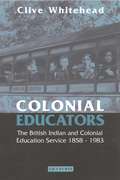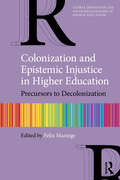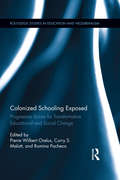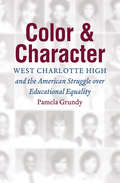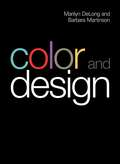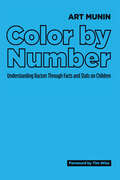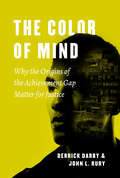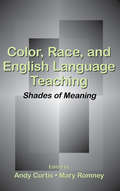- Table View
- List View
Colonial Discourse and the Suffering of Indian American Children: A Francophone Postcolonial Analysis
by Kundan Singh Krishna MaheshwariEuro-American misrepresentations of the non-West in general, and in particular on Hinduism and ancient India, run deep and have far greater colonial connections than that have been exposed in academia. This book analyzes the psycho-social consequences that Indian American children face after they are exposed to the school textbook discourse on Hinduism and ancient India. The authors show that there is an intimate connection—an almost exact correspondence—between James Mill’s colonial-racist discourse and the current school-textbook discourse. The very parameters and coordinates on which James Mill constructed the discourse are the ones that are being used to describe Hinduism, Hindus, and ancient India in the textbooks currently. Consequently, this archaic and racist discourse, camouflaged under the cover of political correctness, produces in the Indian American children a psychological impact quite similar to what racism is known to produce: shame, inferiority, embarrassment, identity confusion, assimilation, and a phenomenon similar to racelessness where the children dissociate from the tradition and culture of their ancestors. This book argues that the current school textbook discourse on Hinduism and India needs to change so that the Indian American children do not become victims of overt and covert racism. For the change to occur, the first step is to recognize the overarching and pervasive influence of the colonial-racist discourse of James Mill on the textbooks. For the reconstruction of the discourse to take place, the first step is to engage in a thorough deconstruction, which is what the book attempts.
Colonial Educators: The British Indian and Colonial Education Service 1858-1983 (International Library of Historical Studies)
by Clive WhiteheadEducation and the British Empire - cultural imperialism or vital preparation for independence and nationhood? This question lies at the root of the history of the education services in India and the colonial territories. Clive Whitehead, a distinguished educationalist, has brought together these studies of the life and work of leading practitioners and covering over 100 years up to the end of empire, the onset of independence and beyond. He includes both administrators and teachers on the ground, like Sir Hans Vischer, Arthur Mayhew, Eric R. J. Hussey, Sir Christopher Cox, Frank Ward, Freda Gwilliam - the 'Great Aunt' of British colonial education, and the great social anthropologist turned educationalist, Margaret Mead. Leading issues are tackled - academic education for the future Platonic Guardians who would run the territories after the British departed, provision of technical and scientific training, the need for mass education and literacy in English and local languages, equal opportunities for all and education for women and, perhaps the most vital principal with global implications - how to link Western knowledge with unique indigenous history and culture.
Colonization and Epistemic Injustice in Higher Education: Precursors to Decolonization (Global Debates on the Decolonialization of Higher Education)
by Felix MaringeProviding coherence in understanding the role that education and higher education played in the colonizing purposes of the rich nations of the North, this book draws from multiple geopolitical spaces across the world to consider how epistemic injustice has characterized colonial higher education systems. Within this text, carefully chosen international contributors explore how colonialism, coloniality, and colonization have impacted indigenous people’s ways of knowing, feeling, behaving, valuing, being, and becoming in fundamental ways and how the West’s idea of education and schooling have been used as key instruments in the project of world domination and subjugation. Beyond these key entry concepts, chapters use ideas of modernity, post-modernism, globalization, internationalization, and neo-liberalism to examine how higher education in colonial and post-colonial societies still answers to a colonial narrative and what can be done to decolonize the system. Unpacking the historical and philosophical antecedents of higher education and critically examining the intentions and impact of colonial assumptions behind higher education in different parts of the world, this is suitable reading for postgraduates and scholars in the field of higher education, as well as senior management teams in universities and practitioners who work directly in the field of transformation in government, and university departments.
Colonization and Epistemic Injustice in Higher Education: Precursors to Decolonization (Global Debates on the Decolonialization of Higher Education)
by Felix MaringeProviding coherence in understanding the role that education and higher education played in the colonizing purposes of the rich nations of the North, this book draws from multiple geopolitical spaces across the world to consider how epistemic injustice has characterized colonial higher education systems. Within this text, carefully chosen international contributors explore how colonialism, coloniality, and colonization have impacted indigenous people’s ways of knowing, feeling, behaving, valuing, being, and becoming in fundamental ways and how the West’s idea of education and schooling have been used as key instruments in the project of world domination and subjugation. Beyond these key entry concepts, chapters use ideas of modernity, post-modernism, globalization, internationalization, and neo-liberalism to examine how higher education in colonial and post-colonial societies still answers to a colonial narrative and what can be done to decolonize the system. Unpacking the historical and philosophical antecedents of higher education and critically examining the intentions and impact of colonial assumptions behind higher education in different parts of the world, this is suitable reading for postgraduates and scholars in the field of higher education, as well as senior management teams in universities and practitioners who work directly in the field of transformation in government, and university departments.
Colonized Schooling Exposed: Progressive Voices for Transformative Educational and Social Change (Routledge Studies in Education, Neoliberalism, and Marxism)
by Pierre Orelus Curry Malott Romina PachecoThis book presents a novel perspective on neocolonialism, education and other related issues. It unveils the effects of neocolonialism on the learning and well-being of students and workers, including marginalized groups such as Native Americans, Latino/as, and African Americans. It is a collection of in-depth interviews with and heartfelt essays by committed social justice educators and scholars genuinely concerned with educational issues situated in the context of western neocolonialism and neoliberalism.This dialogical way of discussing important issues and co-constructing knowledge can be traced back to ancient philosophers, who used dialogue as a form of inquiry to explore and analyze educational, socio-economic and political issues facing the world. It will cover many interwoven and pressing issues echoed through authentic voices of progressive educators and scholars.
Colonized Schooling Exposed: Progressive Voices for Transformative Educational and Social Change (Routledge Studies in Education, Neoliberalism, and Marxism #6)
by Pierre Orelus Curry Malott Romina PachecoThis book presents a novel perspective on neocolonialism, education and other related issues. It unveils the effects of neocolonialism on the learning and well-being of students and workers, including marginalized groups such as Native Americans, Latino/as, and African Americans. It is a collection of in-depth interviews with and heartfelt essays by committed social justice educators and scholars genuinely concerned with educational issues situated in the context of western neocolonialism and neoliberalism.This dialogical way of discussing important issues and co-constructing knowledge can be traced back to ancient philosophers, who used dialogue as a form of inquiry to explore and analyze educational, socio-economic and political issues facing the world. It will cover many interwoven and pressing issues echoed through authentic voices of progressive educators and scholars.
Color and Character: West Charlotte High and the American Struggle over Educational Equality
by Pamela GrundyAt a time when race and inequality dominate national debates, the story of West Charlotte High School illuminates the possibilities and challenges of using racial and economic desegregation to foster educational equality. West Charlotte opened in 1938 as a segregated school that embodied the aspirations of the growing African American population of Charlotte, North Carolina. In the 1970s, when Charlotte began court-ordered busing, black and white families made West Charlotte the celebrated flagship of the most integrated major school system in the nation. But as the twentieth century neared its close and a new court order eliminated race-based busing, Charlotte schools resegregated along lines of class as well as race. West Charlotte became the city's poorest, lowest-performing high school—a striking reminder of the people and places that Charlotte's rapid growth had left behind. While dedicated teachers continue to educate children, the school's challenges underscore the painful consequences of resegregation.Drawing on nearly two decades of interviews with students, educators, and alumni, Pamela Grundy uses the history of a community's beloved school to tell a broader American story of education, community, democracy, and race—all while raising questions about present-day strategies for school reform.
Color and Design
by Marilyn DeLong Barbara MartinsonFrom products we use to clothes we wear, and spaces we inhabit, we rely on colour to provide visual appeal, data codes and meaning. Color and Design addresses how we understand and experience colour, and through specific examples explores how colour is used in a spectrum of design-based disciplines including apparel design, graphic design, interior design, and product design. Through highly engaging contributions from a wide range of international scholars and practitioners, the book explores colour as an individual and cultural phenomenon, as a pragmatic device for communication, and as a valuable marketing tool. Color and Design provides a comprehensive overview for scholars and an accessible text for students on a range of courses within design, fashion, cultural studies, anthropology, sociology and visual and material culture. Its exploration of colour in marketing as well as design makes this book an invaluable resource for professional designers. It will also allow practitioners to understand how and why colour is so extensively varied and offers such enormous potential to communicate.
Color and Design
by Marilyn DeLong Barbara MartinsonFrom products we use to clothes we wear, and spaces we inhabit, we rely on colour to provide visual appeal, data codes and meaning. Color and Design addresses how we understand and experience colour, and through specific examples explores how colour is used in a spectrum of design-based disciplines including apparel design, graphic design, interior design, and product design. Through highly engaging contributions from a wide range of international scholars and practitioners, the book explores colour as an individual and cultural phenomenon, as a pragmatic device for communication, and as a valuable marketing tool. Color and Design provides a comprehensive overview for scholars and an accessible text for students on a range of courses within design, fashion, cultural studies, anthropology, sociology and visual and material culture. Its exploration of colour in marketing as well as design makes this book an invaluable resource for professional designers. It will also allow practitioners to understand how and why colour is so extensively varied and offers such enormous potential to communicate.
Color by Number: Understanding Racism Through Facts and Stats on Children
by Art MuninMany deny that racism remains pervasive in America today. How can we open eyes to the continuing disadvantages that keep many people of color from fulfilling their potential, and having an equal chance to achieve the “American Dream”?By presenting the impact of racism on the most innocent and powerless members of society– children of color – in the form of statistics, this book aims to change attitudes and perceptions. Children have no say about where they are born or what school they attend. They have no control over whether or not they get medical treatment when they fall ill. They can’t avoid exposure if their home is in a community blighted by pollution. The questions this book poses are: What responsibility do we expect children to take for their life circumstances? Do those conditions blight their futures? If they aren’t responsible, who is? Are some in society privileged and complicit in denying people of color the advantages and protections from harm most of us take for granted? Through the cumulative effect of official statistics rather than the more usual reliance on anecdote – by taking a “show me the numbers!” approach – this book will open minds, start conversations, and even prompt readers to take action. While the numbers are official they are often hard to find because they are scattered across so many sources. Art Munin has not only done the research, but shows the reader how to locate data on racial and socio-economic disparities, and develop her or his own case or classroom project.Color by Number takes as its metaphorical point of departure the familiar children’s activity of that name. Art Munin has painstakingly researched and gathered the numbers, and has filled in the spaces to reveal the hidden picture of racism in America from the perspectives of health, the environment, the law, and education.This book is intended as a fact-based, antiracism text for diversity and social justice courses, and as a resource for diversity and social justice educators as they craft their race, racism, and White privilege curricula. Art Munin’s multidisciplinary approach – drawing on scholarly work from medicine, law, sociology, psychology, and education – provides the reader with a comprehensive way to understand the pervasiveness of racism.
Color by Number: Understanding Racism Through Facts and Stats on Children
by Art MuninMany deny that racism remains pervasive in America today. How can we open eyes to the continuing disadvantages that keep many people of color from fulfilling their potential, and having an equal chance to achieve the “American Dream”?By presenting the impact of racism on the most innocent and powerless members of society– children of color – in the form of statistics, this book aims to change attitudes and perceptions. Children have no say about where they are born or what school they attend. They have no control over whether or not they get medical treatment when they fall ill. They can’t avoid exposure if their home is in a community blighted by pollution. The questions this book poses are: What responsibility do we expect children to take for their life circumstances? Do those conditions blight their futures? If they aren’t responsible, who is? Are some in society privileged and complicit in denying people of color the advantages and protections from harm most of us take for granted? Through the cumulative effect of official statistics rather than the more usual reliance on anecdote – by taking a “show me the numbers!” approach – this book will open minds, start conversations, and even prompt readers to take action. While the numbers are official they are often hard to find because they are scattered across so many sources. Art Munin has not only done the research, but shows the reader how to locate data on racial and socio-economic disparities, and develop her or his own case or classroom project.Color by Number takes as its metaphorical point of departure the familiar children’s activity of that name. Art Munin has painstakingly researched and gathered the numbers, and has filled in the spaces to reveal the hidden picture of racism in America from the perspectives of health, the environment, the law, and education.This book is intended as a fact-based, antiracism text for diversity and social justice courses, and as a resource for diversity and social justice educators as they craft their race, racism, and White privilege curricula. Art Munin’s multidisciplinary approach – drawing on scholarly work from medicine, law, sociology, psychology, and education – provides the reader with a comprehensive way to understand the pervasiveness of racism.
Color Charts: A History
by Anne VarichonA beautifully illustrated history of the many inventive, poetic, and alluring ways in which color swatches have been selected and stagedThe need to categorize and communicate color has mobilized practitioners and scholars for centuries. Color Charts describes the many different methods and ingenious devices developed since the fifteenth century by doctors, naturalists, dyers, and painters to catalog fragments of colors. With the advent of industrial society, manufacturers and merchants developed some of the most beautiful and varied tools ever designed to present all the available colors. Thanks to them, society has discovered the abundance of color embodied in a plethora of materials: cuts of fabric, leather, paper, and rubber; slats of wood and linoleum; delicate skeins of silk; careful deposits of paint and pastels; fragments of lipstick; and arrangements of flower petals. These samples shape a visual culture and a chromatic vocabulary and instill a deep desire for color.Anne Varichon traces the emergence of modern color charts from a set of processes developed over the centuries in various contexts. She presents illuminating examples that bring this remarkable story to life, from ancient writings revealing attention to precise shade to contemporary designers&’ color charts, dyers&’ notebooks, and Werner&’s famous color nomenclature. Varichon argues that color charts have linked generations of artists, artisans, scientists, industrialists, and merchants, and have played an essential and enduring role in the way societies think about color.Drawing on nearly two hundred documents from public and private collections, almost all of them previously unpublished, this wonderfully illustrated book shows how the color chart, in its many distinct forms and expressions, is a practical tool that has transcended its original purpose to become an educational aid and subject of contemplation worthy of being studied and admired.
The Color Management Handbook for Visual Effects Artists: Digital Color Principles, Color Management Fundamentals & ACES Workflows
by Victor PerezVictor Perez brings together the research and expertise of world-leading color scientists to create a comprehensive guide for visual effects (VFX) artists in color management. This book explores the latest standards of high dynamic range (HDR) and Academy Color Encoding System (ACES) workflows, in an easily digestible and widely applicable resource. Its purpose is to make artists confident and familiar with Color Management and its science, to improve the quality of visual effects worldwide. Without assuming any previous knowledge, this self-contained book builds the reader’s understanding from the ground up, exploring all the elements of the color workflow at a scientific level. It covers how to set up a consistent pipeline in relation to other departments, inside and outside visual effects, from camera to screen, so everybody is aligned to the same standards, preserving color qualities and consistency while maintaining the artistic intent end to end. It also delves into all the integral concepts for color management, ranging from color theory to digital image fundamentals, and much more. This book is an invaluable resource for VFX students and professionals who want to be well informed about the latest HDR and ACES pipelines, as well as those at every level of production wishing to gain a deeper understanding of managing color in visual effects projects.
The Color Management Handbook for Visual Effects Artists: Digital Color Principles, Color Management Fundamentals & ACES Workflows
by Victor PerezVictor Perez brings together the research and expertise of world-leading color scientists to create a comprehensive guide for visual effects (VFX) artists in color management. This book explores the latest standards of high dynamic range (HDR) and Academy Color Encoding System (ACES) workflows, in an easily digestible and widely applicable resource. Its purpose is to make artists confident and familiar with Color Management and its science, to improve the quality of visual effects worldwide. Without assuming any previous knowledge, this self-contained book builds the reader’s understanding from the ground up, exploring all the elements of the color workflow at a scientific level. It covers how to set up a consistent pipeline in relation to other departments, inside and outside visual effects, from camera to screen, so everybody is aligned to the same standards, preserving color qualities and consistency while maintaining the artistic intent end to end. It also delves into all the integral concepts for color management, ranging from color theory to digital image fundamentals, and much more. This book is an invaluable resource for VFX students and professionals who want to be well informed about the latest HDR and ACES pipelines, as well as those at every level of production wishing to gain a deeper understanding of managing color in visual effects projects.
The Color of Mind: Why the Origins of the Achievement Gap Matter for Justice (History and Philosophy of Education Series)
by Derrick Darby John L. RuryAmerican students vary in educational achievement, but white students in general typically have better test scores and grades than black students. Why is this the case, and what can school leaders do about it? In The Color of Mind, Derrick Darby and John L. Rury answer these pressing questions and show that we cannot make further progress in closing the achievement gap until we understand its racist origins. Telling the story of what they call the Color of Mind—the idea that there are racial differences in intelligence, character, and behavior—they show how philosophers, such as David Hume and Immanuel Kant, and American statesman Thomas Jefferson, contributed to the construction of this pernicious idea, how it influenced the nature of schooling and student achievement, and how voices of dissent such as Frederick Douglass, Frances Ellen Watkins Harper, and W. E. B. Du Bois debunked the Color of Mind and worked to undo its adverse impacts. Rejecting the view that racial differences in educational achievement are a product of innate or cultural differences, Darby and Rury uncover the historical interplay between ideas about race and American schooling, to show clearly that the racial achievement gap has been socially and institutionally constructed. School leaders striving to bring justice and dignity to American schools today must work to root out the systemic manifestations of these ideas within schools, while still doing what they can to mitigate the negative effects of poverty, segregation, inequality, and other external factors that adversely affect student achievement. While we cannot expect schools alone to solve these vexing social problems, we must demand that they address the dignitary injustices associated with how we track, discipline, and deal with special education that reinforce long-standing racist ideas. That is the only way to expel the Color of Mind from schools, close the racial achievement gap, and afford all children the dignity they deserve.
The Color of Mind: Why the Origins of the Achievement Gap Matter for Justice (History and Philosophy of Education Series)
by Derrick Darby John L. RuryAmerican students vary in educational achievement, but white students in general typically have better test scores and grades than black students. Why is this the case, and what can school leaders do about it? In The Color of Mind, Derrick Darby and John L. Rury answer these pressing questions and show that we cannot make further progress in closing the achievement gap until we understand its racist origins. Telling the story of what they call the Color of Mind—the idea that there are racial differences in intelligence, character, and behavior—they show how philosophers, such as David Hume and Immanuel Kant, and American statesman Thomas Jefferson, contributed to the construction of this pernicious idea, how it influenced the nature of schooling and student achievement, and how voices of dissent such as Frederick Douglass, Frances Ellen Watkins Harper, and W. E. B. Du Bois debunked the Color of Mind and worked to undo its adverse impacts. Rejecting the view that racial differences in educational achievement are a product of innate or cultural differences, Darby and Rury uncover the historical interplay between ideas about race and American schooling, to show clearly that the racial achievement gap has been socially and institutionally constructed. School leaders striving to bring justice and dignity to American schools today must work to root out the systemic manifestations of these ideas within schools, while still doing what they can to mitigate the negative effects of poverty, segregation, inequality, and other external factors that adversely affect student achievement. While we cannot expect schools alone to solve these vexing social problems, we must demand that they address the dignitary injustices associated with how we track, discipline, and deal with special education that reinforce long-standing racist ideas. That is the only way to expel the Color of Mind from schools, close the racial achievement gap, and afford all children the dignity they deserve.
The Color of Mind: Why the Origins of the Achievement Gap Matter for Justice (History and Philosophy of Education Series)
by Derrick Darby John L. RuryAmerican students vary in educational achievement, but white students in general typically have better test scores and grades than black students. Why is this the case, and what can school leaders do about it? In The Color of Mind, Derrick Darby and John L. Rury answer these pressing questions and show that we cannot make further progress in closing the achievement gap until we understand its racist origins. Telling the story of what they call the Color of Mind—the idea that there are racial differences in intelligence, character, and behavior—they show how philosophers, such as David Hume and Immanuel Kant, and American statesman Thomas Jefferson, contributed to the construction of this pernicious idea, how it influenced the nature of schooling and student achievement, and how voices of dissent such as Frederick Douglass, Frances Ellen Watkins Harper, and W. E. B. Du Bois debunked the Color of Mind and worked to undo its adverse impacts. Rejecting the view that racial differences in educational achievement are a product of innate or cultural differences, Darby and Rury uncover the historical interplay between ideas about race and American schooling, to show clearly that the racial achievement gap has been socially and institutionally constructed. School leaders striving to bring justice and dignity to American schools today must work to root out the systemic manifestations of these ideas within schools, while still doing what they can to mitigate the negative effects of poverty, segregation, inequality, and other external factors that adversely affect student achievement. While we cannot expect schools alone to solve these vexing social problems, we must demand that they address the dignitary injustices associated with how we track, discipline, and deal with special education that reinforce long-standing racist ideas. That is the only way to expel the Color of Mind from schools, close the racial achievement gap, and afford all children the dignity they deserve.
The Color of Mind: Why the Origins of the Achievement Gap Matter for Justice (History and Philosophy of Education Series)
by Derrick Darby John L. RuryAmerican students vary in educational achievement, but white students in general typically have better test scores and grades than black students. Why is this the case, and what can school leaders do about it? In The Color of Mind, Derrick Darby and John L. Rury answer these pressing questions and show that we cannot make further progress in closing the achievement gap until we understand its racist origins. Telling the story of what they call the Color of Mind—the idea that there are racial differences in intelligence, character, and behavior—they show how philosophers, such as David Hume and Immanuel Kant, and American statesman Thomas Jefferson, contributed to the construction of this pernicious idea, how it influenced the nature of schooling and student achievement, and how voices of dissent such as Frederick Douglass, Frances Ellen Watkins Harper, and W. E. B. Du Bois debunked the Color of Mind and worked to undo its adverse impacts. Rejecting the view that racial differences in educational achievement are a product of innate or cultural differences, Darby and Rury uncover the historical interplay between ideas about race and American schooling, to show clearly that the racial achievement gap has been socially and institutionally constructed. School leaders striving to bring justice and dignity to American schools today must work to root out the systemic manifestations of these ideas within schools, while still doing what they can to mitigate the negative effects of poverty, segregation, inequality, and other external factors that adversely affect student achievement. While we cannot expect schools alone to solve these vexing social problems, we must demand that they address the dignitary injustices associated with how we track, discipline, and deal with special education that reinforce long-standing racist ideas. That is the only way to expel the Color of Mind from schools, close the racial achievement gap, and afford all children the dignity they deserve.
The Color of Mind: Why the Origins of the Achievement Gap Matter for Justice (History and Philosophy of Education Series)
by Derrick Darby John L. RuryAmerican students vary in educational achievement, but white students in general typically have better test scores and grades than black students. Why is this the case, and what can school leaders do about it? In The Color of Mind, Derrick Darby and John L. Rury answer these pressing questions and show that we cannot make further progress in closing the achievement gap until we understand its racist origins. Telling the story of what they call the Color of Mind—the idea that there are racial differences in intelligence, character, and behavior—they show how philosophers, such as David Hume and Immanuel Kant, and American statesman Thomas Jefferson, contributed to the construction of this pernicious idea, how it influenced the nature of schooling and student achievement, and how voices of dissent such as Frederick Douglass, Frances Ellen Watkins Harper, and W. E. B. Du Bois debunked the Color of Mind and worked to undo its adverse impacts. Rejecting the view that racial differences in educational achievement are a product of innate or cultural differences, Darby and Rury uncover the historical interplay between ideas about race and American schooling, to show clearly that the racial achievement gap has been socially and institutionally constructed. School leaders striving to bring justice and dignity to American schools today must work to root out the systemic manifestations of these ideas within schools, while still doing what they can to mitigate the negative effects of poverty, segregation, inequality, and other external factors that adversely affect student achievement. While we cannot expect schools alone to solve these vexing social problems, we must demand that they address the dignitary injustices associated with how we track, discipline, and deal with special education that reinforce long-standing racist ideas. That is the only way to expel the Color of Mind from schools, close the racial achievement gap, and afford all children the dignity they deserve.
The Color of Mind: Why the Origins of the Achievement Gap Matter for Justice (History and Philosophy of Education Series)
by Derrick Darby John L. RuryAmerican students vary in educational achievement, but white students in general typically have better test scores and grades than black students. Why is this the case, and what can school leaders do about it? In The Color of Mind, Derrick Darby and John L. Rury answer these pressing questions and show that we cannot make further progress in closing the achievement gap until we understand its racist origins. Telling the story of what they call the Color of Mind—the idea that there are racial differences in intelligence, character, and behavior—they show how philosophers, such as David Hume and Immanuel Kant, and American statesman Thomas Jefferson, contributed to the construction of this pernicious idea, how it influenced the nature of schooling and student achievement, and how voices of dissent such as Frederick Douglass, Frances Ellen Watkins Harper, and W. E. B. Du Bois debunked the Color of Mind and worked to undo its adverse impacts. Rejecting the view that racial differences in educational achievement are a product of innate or cultural differences, Darby and Rury uncover the historical interplay between ideas about race and American schooling, to show clearly that the racial achievement gap has been socially and institutionally constructed. School leaders striving to bring justice and dignity to American schools today must work to root out the systemic manifestations of these ideas within schools, while still doing what they can to mitigate the negative effects of poverty, segregation, inequality, and other external factors that adversely affect student achievement. While we cannot expect schools alone to solve these vexing social problems, we must demand that they address the dignitary injustices associated with how we track, discipline, and deal with special education that reinforce long-standing racist ideas. That is the only way to expel the Color of Mind from schools, close the racial achievement gap, and afford all children the dignity they deserve.
The Color of School Reform: Race, Politics, and the Challenge of Urban Education
by Jeffrey R. Henig Richard C. Hula Marion Orr Desiree S. PedescleauxWhy is it so difficult to design and implement fundamental educational reform in large city schools in spite of broad popular support for change? How does the politics of race complicate the challenge of building and sustaining coalitions for improving urban schools? These questions have provoked a great deal of theorizing, but this is the first book to explore the issues on the basis of extensive, solid evidence. Here a group of political scientists examines education reform in Atlanta, Baltimore, Detroit, and Washington, D.C., where local governmental authority has passed from white to black leaders. The authors show that black administrative control of big-city school systems has not translated into broad improvements in the quality of public education within black-led cities. Race can be crucial, however, in fostering the broad civic involvement perhaps most needed for school reform. In each city examined, reform efforts often arise but collapse, partly because leaders are unable to craft effective political coalitions that would commit community resources to a concrete policy agenda. What undermines the leadership, according to the authors, is the complex role of race in each city. First, public authority does not guarantee access to private resources, usually still controlled by white economic elites. Second, local authorities must interact with external actors, at the state and national levels, who remain predominantly white. Finally, issues of race divide the African American community itself and often place limits on what leaders can and cannot do. Filled with insightful explanations together with recommendations for policy change, this book is an important component of the debate now being waged among researchers, education activists, and the community as a whole.
The Color of School Reform: Race, Politics, and the Challenge of Urban Education
by Marion Orr Jeffrey R. Henig Richard C. Hula Desiree S. PedescleauxWhy is it so difficult to design and implement fundamental educational reform in large city schools in spite of broad popular support for change? How does the politics of race complicate the challenge of building and sustaining coalitions for improving urban schools? These questions have provoked a great deal of theorizing, but this is the first book to explore the issues on the basis of extensive, solid evidence. Here a group of political scientists examines education reform in Atlanta, Baltimore, Detroit, and Washington, D.C., where local governmental authority has passed from white to black leaders. The authors show that black administrative control of big-city school systems has not translated into broad improvements in the quality of public education within black-led cities. Race can be crucial, however, in fostering the broad civic involvement perhaps most needed for school reform. In each city examined, reform efforts often arise but collapse, partly because leaders are unable to craft effective political coalitions that would commit community resources to a concrete policy agenda. What undermines the leadership, according to the authors, is the complex role of race in each city. First, public authority does not guarantee access to private resources, usually still controlled by white economic elites. Second, local authorities must interact with external actors, at the state and national levels, who remain predominantly white. Finally, issues of race divide the African American community itself and often place limits on what leaders can and cannot do. Filled with insightful explanations together with recommendations for policy change, this book is an important component of the debate now being waged among researchers, education activists, and the community as a whole.
The Color of Teaching
by June GordonOne of the major concerns in education at present is how to recruit and attract more teachers from ethnic minorities. In an attempt to move beyond the superficial and simplistic responses as to why these students are not entering teaching this book presents in-depth interviews with over two hundred people from four ethnic groups: African Americans, Native Americans, Asian Americans and Latinos.These interviewees, many of them teachers or education professionals, express their attitude towards teaching and their understanding of why others may not choose teaching as a career. One of the most significant and surprising findings is that, regardless of academic or socio-economic standing, students from these ethnic groups tend not to be encouraged to enter the teaching profession by their own families communities and peers. The book concludes with a discussion of programmatic changes and calls for the reconceptualization of the role of teachers. Such changes can only arise out of a fundamental change in attitude of communities of color towards teaching which must be led by teachers themselves.
The Color of Teaching
by June GordonOne of the major concerns in education at present is how to recruit and attract more teachers from ethnic minorities. In an attempt to move beyond the superficial and simplistic responses as to why these students are not entering teaching this book presents in-depth interviews with over two hundred people from four ethnic groups: African Americans, Native Americans, Asian Americans and Latinos.These interviewees, many of them teachers or education professionals, express their attitude towards teaching and their understanding of why others may not choose teaching as a career. One of the most significant and surprising findings is that, regardless of academic or socio-economic standing, students from these ethnic groups tend not to be encouraged to enter the teaching profession by their own families communities and peers. The book concludes with a discussion of programmatic changes and calls for the reconceptualization of the role of teachers. Such changes can only arise out of a fundamental change in attitude of communities of color towards teaching which must be led by teachers themselves.
Color, Race, and English Language Teaching: Shades of Meaning
by Andy Curtis Mary RomneyThe unique contribution of this book is to bring together Critical Race Theory and narrative inquiry and apply them specifically to a largely overlooked area of experience within the field of TESOL: What does it mean to be a TESOL professional of color? To address this question, TESOL professionals of color from all over the world, representing a wide range of racial, ethnic, and cultural backgrounds, offer accounts of their own experiences, responding to two related questions:*Can you identify critical events or conditions in your personal or professional life that are the result of you being a person of color that affect who you are now and what you do as a TESOL professional of color?*What have you learned from these events or conditions that have had a bearing on your life as a TESOL professional of color? Color, Race, and English Language Teaching: Shades of Meaning is intended for researchers, professionals, and students in the field of English language teaching. The book is designed as a text for MATESOL programs and courses that deal with issues of language, culture, and teaching. The introduction presents a brief overview of relevant aspects of Critical Race Theory, narrative inquiry, and educational research. Focus questions for each chapter are included to help readers apply aspects of the narratives to their own experience.

